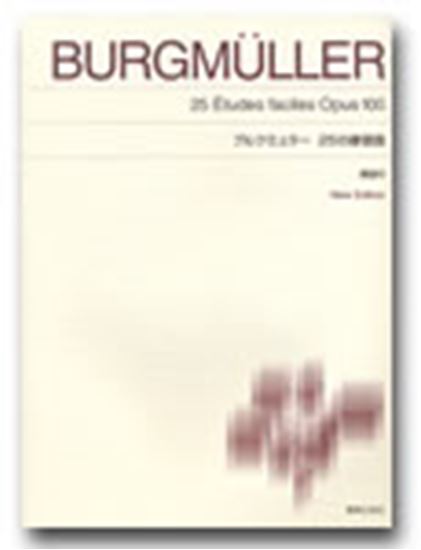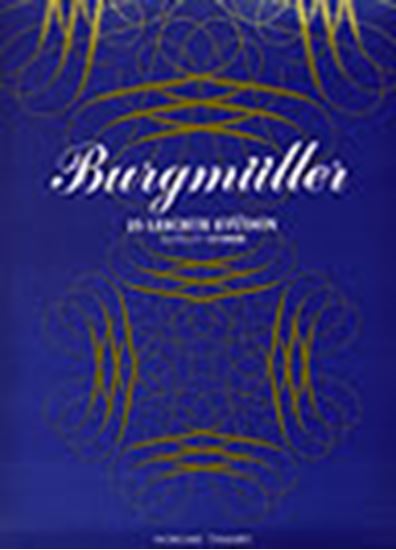Burgmüller, Johann Friedrich Franz : 25 Etudes faciles et progressives, conposées et doigtées expressément pour l'étendue des petites mains Le petite reunion Op.100-4
Work Overview
Genre:etude
Total Playing Time:1 min 30 sec
Copyright:Public Domain
Additional Notes:表記ゆれの例: 子供の集会 子どもの集会 小さな集い 子どもたちの集い 子どものパーティー 子供のパーティー こども会
Commentary (3)
Author : Sato, Takashi
Last Updated: January 31, 2022
[Open]
Author : Sato, Takashi
Weber's opera Der Freischütz. Its character stems from being almost entirely constructed from diatonic chords in C major, with the sole exception of the A-flat appearing twice in measures 19 and 20. This A-flat is a Moll-Dur (borrowed from the parallel minor), and the sforzando emphasizes the unsettling character of this diminished triad.
Performance Points (Original Tempo ♩=152)
- This piece serves as practice for playing thirds.
- For the right-hand staccato in measures 2 and 4, playing with consecutive 2nd and 4th fingers makes it easy to achieve uniformity. However, if using consecutive 5-3/4-2/3-1 fingerings, ensure a smooth, even sound.
- The main section from measure 7 onwards features legato double notes.
- Avoid accenting the second and fourth beats.
- In measure 8, the first chord (E-G) and the second chord (C-E) do not connect easily. Slightly shorten the inner voice E of the first chord to allow for a legato connection between the soprano G and E.
In measures 13 and 29, the double notes become sixths. Aim for a beautiful balance by creating a greater dynamic difference between the soprano and alto voices than you would for thirds.
(From To-on Edition "Burgmüller 25 Etudes" (NS70))
Author : Iida, Arisa
Last Updated: March 15, 2018
[Open]
Author : Iida, Arisa
Musical example provided by: Ongaku no Tomo Sha
Author : Ooi, Kazurou
Last Updated: January 31, 2019
[Open]
Author : Ooi, Kazurou
Technical Demands
Although it is a simple piece, it falls into the category of technically difficult compositions. To play this piece, the learner requires strong and resilient fingers. Without strong 3rd, 4th, and 5th fingers in the right hand, it is difficult to play well. In that sense, it might be advisable to postpone this piece.
Achieving Dimensionality
Alongside technique, a crucial aspect when performing this piece is to "create a sense of three-dimensionality" or "depth." This implies treating the piece polyphonically. There are several musical materials, and by varying the timbre of each, a sense of depth can be achieved.
Analysis of Opening Measures
The left hand in measures 1-2 and measures 3-4 at the beginning are the same musical material. In the Zen-On edition, the left hand in measure 1 is marked p. However, even within the p dynamic, strive to play with a deep, rich tone, singing out clearly. Avoid a mechanical execution. Play the left hand in measures 1-4 cantabile, singing it out. The right hand in measures 3 and 5 constitutes another musical material. In my personal opinion, playing the right hand in measures 3 and 5 pp and staccato, with a light touch, creates a clear contrast with the left hand, allowing it to be distinctly heard as a separate material. If "Children's Gathering" is the correct translation for the title, then this staccato, descending third figure in the right hand could be interpreted as children's laughter.
Dynamic Considerations in Measure 5
In measure 5, pay attention to the placement of the forte. Remember that the forte begins on the third beat, and the first beat should end p.
Interpreting the Theme from Measure 7
Now, the theme begins from measure 7; let's focus on the left-hand line. The left hand in measures 7-10 might not be considered a melodic line, but play it smoothly and legato, singing it out as if it were a cello. Furthermore, the right hand from measure 7 to measure 12 proceeds in thirds; strive to bring out the top (upper) note as much as possible.
Right-Hand Articulation and Fingering Challenges
And what requires particular attention is the right-hand articulation. Let's consider how to approach this. In measure 7, two slurs are written: one for beats 1-2 and another for beats 3-4. Therefore, there is no particular necessity to connect beat 2 to beat 3, nor is there a strict requirement to break the connection. While this is up to the performer's discretion, the passage from the third beat of measure 7 to the first beat of measure 8 is written as a single phrase. In this case, if you strictly follow the fingering in the Zen-On edition, it becomes impossible to connect the last note of measure 7 (F-A) to the first note of measure 8 (E-G). Therefore, by using fingering 2-1 for the first note of measure 8 (E-G), it becomes possible to connect legato from measure 7.
Strategic Pedal Application
Then, in measure 8, if you end with 2-1, it becomes impossible to maintain legato for the entire measure using only fingers, so use the pedal. Briefly depress the pedal at the 2-1 fingering to ensure the connection is not broken until the 3-1 fingering on the second beat. In this manner, skillfully use the pedal to prevent the right-hand line from being interrupted. Of course, in passages like measure 10, no pedal should be used at all.
Further Pedal Considerations and Material Distinction
The pedal becomes particularly necessary in passages involving sixths, such as in measure 13. In the case of sixths, it is impossible to connect both the lower and upper notes with fingers alone. Please use the pedal. Furthermore, in measure 14, consider the melody to end on the first beat, and treat beats 2-3 as a separate musical material. Therefore, playing these two to three beats pp allows for a clear distinction between the materials.
Concluding Remark
For your reference.
Arrangements & Related Works(5)
Haruhata, Celéri: ロッパチ2(轟千尋と共著) 3. 小さなつどい(6手連弾)
Total Performance Time: 1 min 30 sec
PTNA & Partner Channel Videos(18items) View More
Sheet MusicView More
Scores List (25)

(株)東音企画(バスティン)

(株)東音企画(バスティン)

(株)東音企画(バスティン)

(株)エー・ティ・エヌ

(株)全音楽譜出版社

(株)ドレミ楽譜出版社

(株)音楽之友社

KMP(ケイ・エム・ピー) ケイエムピー

(株)ドレミ楽譜出版社

ハンナ(ショパン)

(株)ヤマハミュージックエンタテインメントホールディングス

デプロMP

(株)ドレミ楽譜出版社

(株)全音楽譜出版社

(株)ドレミ楽譜出版社

カワイ出版

カワイ出版

デプロMP

(株)ヤマハミュージックエンタテインメントホールディングス

デプロMP

(株)音楽之友社

(株)共同音楽出版社

Neil A. Kjos Music Company



















